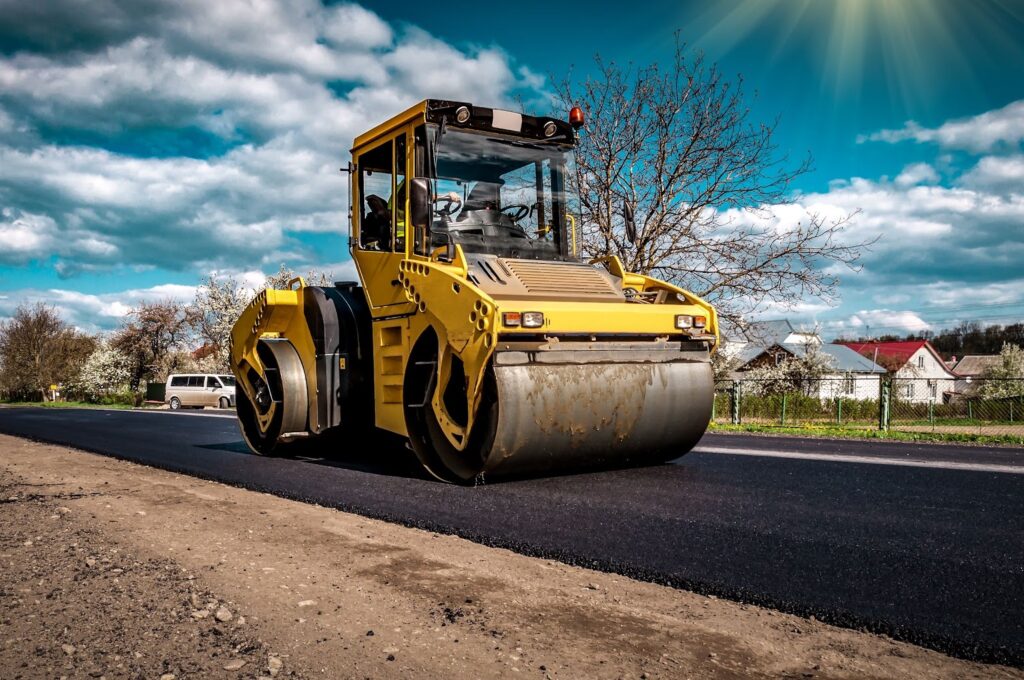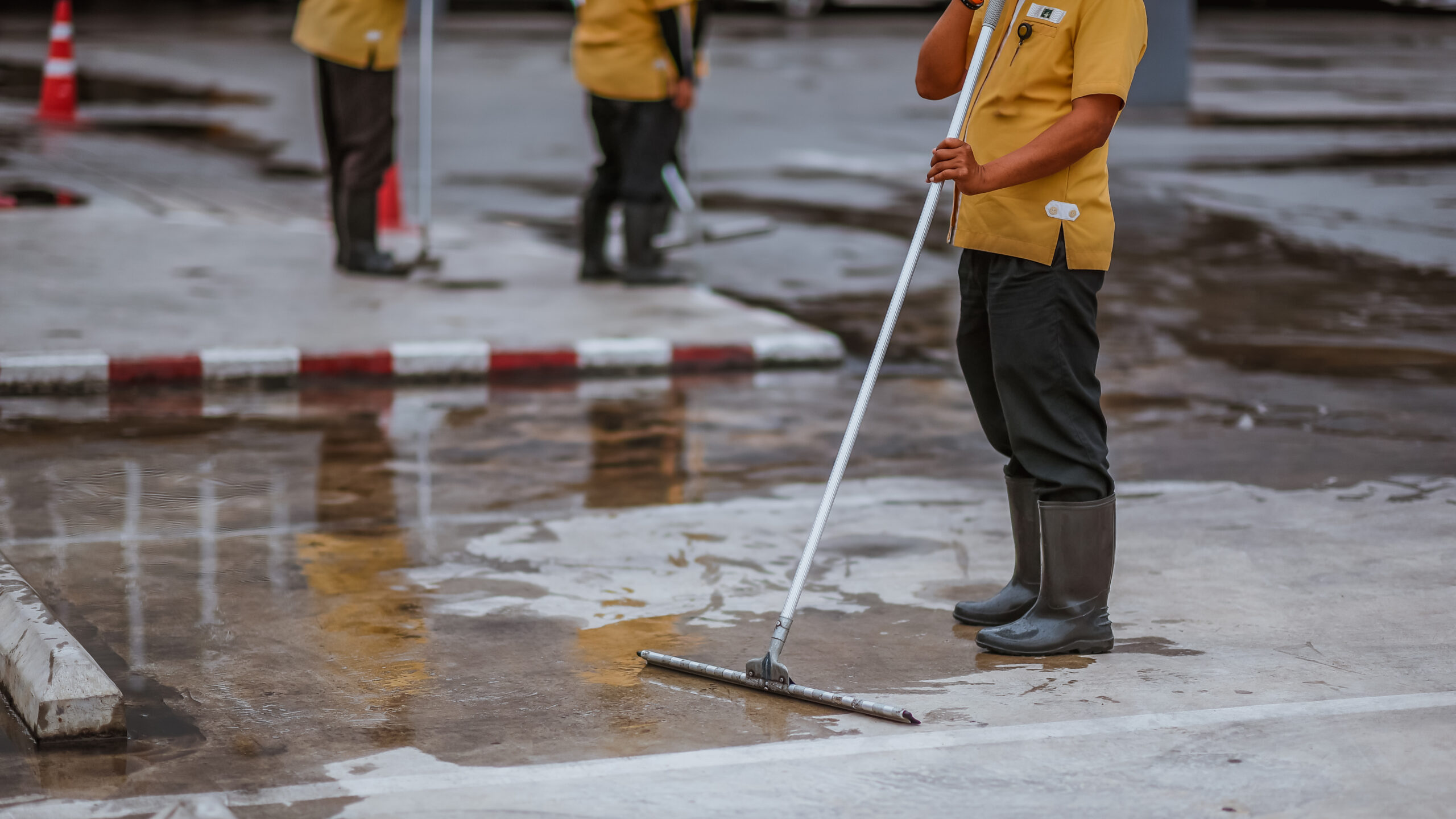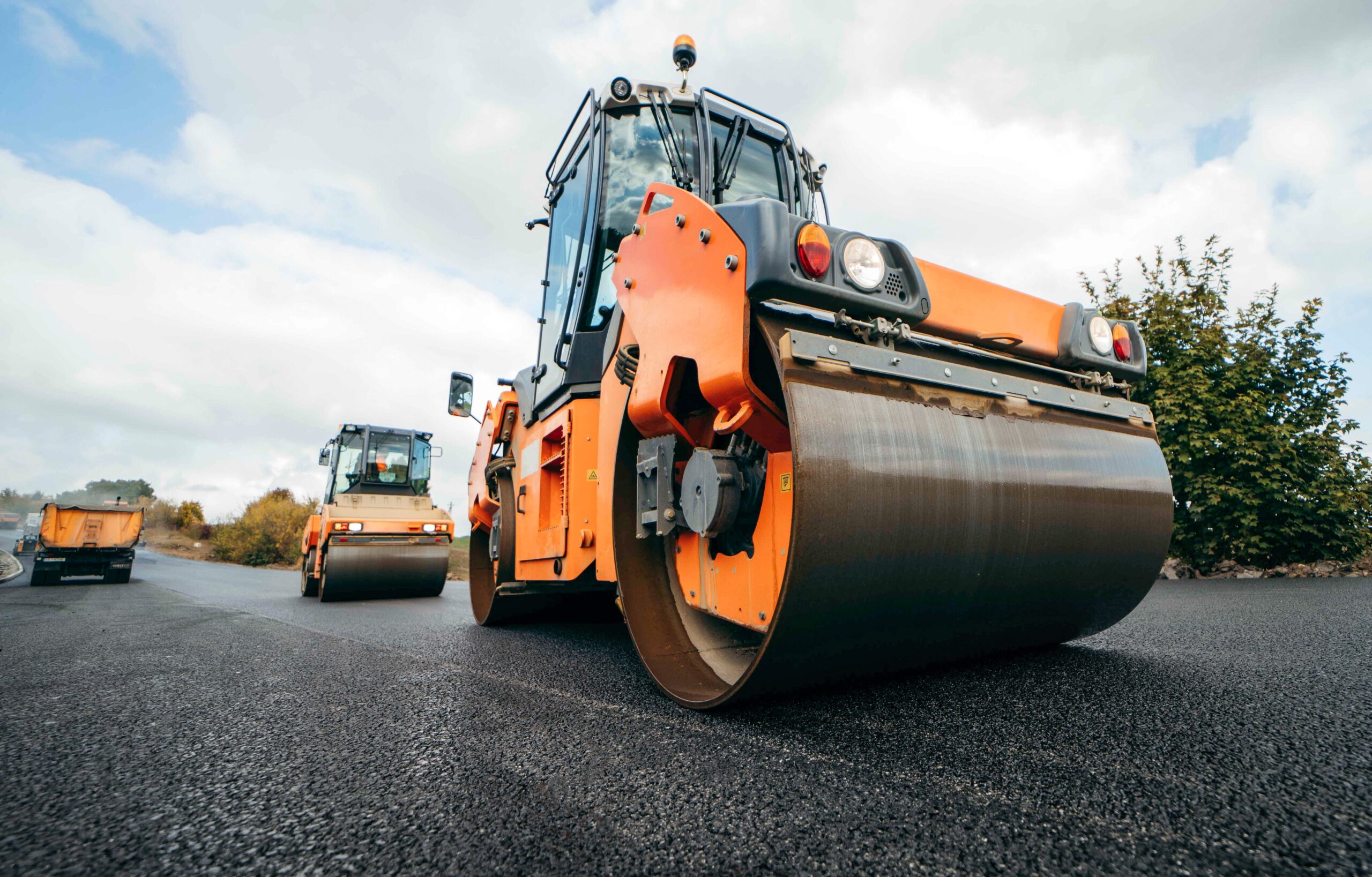Asphalt and concrete solutions concern the construction, maintenance, and repair of paved surfaces. These products are key infrastructure components, providing safety, accessibility, and aesthetics on residential, commercial, and municipal projects.
Asphalt is appreciated due to its malleability, smoothness, and economical cost and is, therefore, the most desirable surface in most roads and parking spaces. Concrete is stronger and more durable, which makes it best suited for high-load structures like highways, bridges, and airport runways. Both are designed to withstand harsh environmental conditions, providing long-lasting performance.
The Federal Highway Administration (FHWA) has estimated that 94 percent of the paved roads in the United States have an asphalt surface. In contrast, concrete is the predominant paving material in more structurally demanding areas.
As urbanization increases and age-old infrastructure and climate-related degradations become the order of the day, demand is skyrocketing. This guide will explain the types of services, maintenance plans, and the best materials for your project.
What is Asphalt Paving?

For property owners and businesses seeking reliable surfacing solutions, commercial asphalt paving offers a cost-effective and long-lasting option. It involves laying an optimally designed aggregate blend, typically crushed stone, sand, and gravel, bound together with bitumen, a petroleum-based binder, on a properly prepared surface. Once compacted, this process delivers a smooth, flexible, and durable pavement capable of withstanding heavy traffic and diverse weather conditions. The growing importance of these solutions can be seen in the global market, valued at $65.9 billion in 2024 and projected to reach $83.4 billion by 2030 (Grand View Research).
It is the most popular form of paving in the construction of roads, driveways, car parks, cycle tracks, airline runways, and other places with massive traffic. It is also popular due to its affordability, comparatively shorter installation time compared to others, and the fact that the surfaces can be brought back to use shortly after completion. The plasticity of the asphalt also helps it withstand temperature variations without cracking, as it is less hard.
In addition to functionality, asphalt paving plays a substantial role in environmental sustainability. NAPA reports that over 94 million tons of asphalt pavements were recycled annually in the United States, which places it as the most recycled product in the construction-related industry. This level of recycling reduces the need for new raw materials, reduces the amount of energy needed, and directly contributes to the sustainability goals (NAPA, 2023).
History of Asphalt Paving
Asphalt dates back to Babylonia, where bitumen was applied in the urban streets. During the 1800s, European road pioneers experimented with natural asphalt as a road surface. By the early 20th century, modern petroleum-based asphalt became standard. It provided ease of rides and durability. Modern road construction began in 1870, laying the first asphalt pavement in the United States in Newark, New Jersey.
What is Concrete Paving?
For large-scale projects requiring maximum durability and load-bearing capacity, commercial concrete paving is a dependable choice. This process combines cement, water, and aggregates to create rigid and highly durable surfaces, making it ideal for highways, airport runways, sidewalks, curbs, and even commercial floors. While concrete takes longer to cure compared to asphalt, its stiffness allows it to carry heavy loads efficiently and sustain long service lives.
Research conducted by the Portland Cement Association indicates that concrete pavements can be maintained to a service life of 30-40 years as opposed to a maximum of 15-20 years in asphalt (PCA, 2023). This explains why concrete is suitable for long-life infrastructure.
Concrete in Construction
For developers and contractors planning major projects, new construction paving services offer concrete as a highly versatile and durable construction material solution. Due to its versatility, it finds large-scale applications in concrete sidewalks, curbs, gutter systems, and structural slabs. Concrete can be used in many places, both practical and decorative.
Due to its compressive strength, concrete is a good choice for warehouses, manufacturing plants, and distribution centers. Steel rebars or fibers can be added to concrete to increase its tensile strength further; hence, they are used in bridges, parking structures, and foundations of high-rise buildings.
The modern concrete technology has also gained its scope. The improved mix design, incorporating high-performance concrete (HPC), previous concrete for stormwater management, and decorative stamped concrete as an aesthetic feature, has enhanced its value for infrastructure and design-oriented projects.
Asphalt Repair Services
Asphalt repair is the process of repairing damaged pavements to enhance safety, extend their functional life, and ensure a smooth driving or walking surface. Damaged pavements can quickly become safety hazards and costly liabilities, which is why professional asphalt repair services are essential for maintaining smooth and durable surfaces.
Timely repairs not only improve safety but also extend the functional life of the pavement, helping property owners avoid the higher expenses of major restructuring later on. Common repair methods include pothole patching, crack sealing, infrared repairing, and full resurfacing, each tailored to address different levels of wear and tear.
The magnitude of the indigence is intense. According to the American Society of Civil Engineers (ASCE), over forty percent of U.S. roads are of poor or mediocre quality, supporting the necessity of regular maintenance and intervention (ASCE Report Card, 2021).
Some Common Asphalt Problems
Depending on environmental conditions and traffic load, pavement damage can develop gradually or occur suddenly. Common issues that arise include cracks, potholes, and surface deterioration. However, there are often mistakes that damage asphalt faster than expected. By understanding and avoiding these errors, you can prevent accelerated wear and prolong the life of your pavement.
- Cracking: This usually occurs due to temperature changes, water ingress, or heavy weights. In the absence of sealing, the cracks expand and weaken the structure.
- Potholes: These are caused by water seeping into the pavement, freezing, and expanding, which breaks the asphalt apart. They may damage vehicles and pose a safety risk.
- Raveling: It occurs when aggregate starts to wash away, resulting in a rough surface and decreased skid resistance.
When not dealt with on time, these issues escalate pavement degradation, increasing the repair costs.
Different Types of Asphalt Repairs
Various degrees of damage require varied repair methods. Here are the four different types of asphalt repairs that are used in both residential and commercial projects:
- Crack Sealing: Fills and seals cracks to prevent water from seeping into the base, which is ideal during the early stages of the problem.
- Pothole Patching: Cold or hot mix asphalt can be used to fill potholes. It’s not permanent, but a quick fix for localized damage.
- Resurfacing (Overlay): A layer of new asphalt is applied over an existing surface, making it smooth and extending its life.
- Infrared Repair: This method heats the damaged area, eliminating the need to remove the damaged pavement. It is followed by repaving with new asphalt to fit perfectly with the old pavement, giving it a durable, seamless appearance.
An essential factor in repair frequency is climate. In freeze-thaw areas, cracks may proliferate in winter, resurfacing every 2-3 years if not maintained. Where the climate is less severe, repairs may be timed much farther apart with careful maintenance.
New Asphalt Construction Services
New asphalt construction involves the creation of new paved surfaces that offer structural integrity and long-term performance. The procedure typically involves preparing the sites, grading, and compacting the bases, the binding layers, and lastly, the top asphalt layer. All the steps are essential. A good base preparation will eliminate early cracking and rutting, and correct compaction will leave the surface smooth and stable.
This is a fundamental service to the new development of residential subdivisions, business parking, industrial access roads, and municipal infrastructure projects. Quality buildings enhance utility and safety and minimize maintenance costs in the long run.
However, even with best practices, common asphalt construction mistakes that can jeopardize the longevity of your new surface. Avoiding these errors is essential for achieving lasting results.
The industry is significant because of its scale. According to IBISWorld estimates, the U.S. market for asphalt manufacturing reaches more than 30 billion dollars every year and consists of new constructions and renovation projects.
Choosing the Right Asphalt Mix
Pavement performance is dependent on the choice of the proper asphalt mix. The selection is based on the traffic load, climate, and purpose. The usual options are:
- Dense-Graded Mix: An all-purpose mix ideal for most roads and parking lots.
- Stone Matrix Asphalt (SMA): This was developed for use in high traffic and provides greater durability and resistance to rutting.
- Open-Graded Mix: Provides improved wet-weather skid resistance and less severe water damage due to improved drainage.
According to FHWA research, achieving just a 1 percent increase in asphalt compaction can extend pavement service life by at least 10 percent. This means that proper mix selection is an investment in performance and sustainability.
Parking Lot Maintenance Services
Parking lots experience a wide range of loads, from passenger cars to delivery trucks, and constant weather conditions. If surfaces aren’t properly maintained, they can deteriorate quickly. This can compromise safety and diminish curb appeal. Regularly scheduled parking lot maintenance services ensure the longevity of your lot, enhancing its safety, retaining its visual appeal, and avoiding the high costs of complete replacements.
Core services include crack sealing, striping, sealcoating, pothole repair, and drainage. A combination of these measures will address structural and visual issues, maintaining parking lot areas functional and professional in appearance.
Research demonstrates that with proper maintenance, a parking lot can have twice the effective life, save thousands of dollars in long-term replacement costs, and save your investment.
The Importance of Parking Lot Striping
The striping makes the parking space, directional arrows, and traffic lanes visible to lead drivers and enhance the flow of traffic effectively. Properly planned striping also raises pedestrian and vehicle safety and maximizes available spaces.
Parking lot striping services not only ensure functionality but also refresh the overall appearance of your property, providing a clean, professional look that boosts curb appeal.
Parking Lot Crack Sealing
The early symptoms of any pavement deterioration are cracks, and they can be easily transformed into serious problems if left untreated. When exposed, they allow water to seep in the bottom layer, weaken it, and eventually end up creating potholes.
Early parking lot crack sealing prevents this by sealing cracks before they cause further damage, helping to maintain the integrity of the surface and significantly extending the lifespan of the pavement.
Benefits of Sealcoating Parking Lots
Parking Lots Sealcoating is a shield against oxidation, UV rays, and water intrusions. It decreases asphalt’s natural abrasion, keeps the surface smooth, and makes it more attractive through a rich, dark appearance. According to industry data, sealcoating can lengthen pavement service lives by 30-50%, resulting in less frequent repairs and a total reduction in maintenance costs in the long run.
Concrete Services for Construction & Repair
Concrete services include a wide range of installation and repair services for commercial and residential jobs. Concrete is a strong and versatile building material, whether used in new construction or the rehabilitation of old structures. The most common uses are foundations, curbs, patios, driveways, sidewalks, and structural pads, and all are made to be strong, stable, and long-term performers.
Concrete Curb and Gutter Installation
Effective water management requires curbs and gutters. They direct water off roads, car parks, and footpaths, thus avoiding stagnation, erosion, and damage to nearby buildings. In addition to their service, curbs and gutters also improve the general aesthetics of streets and parking, adding a clean and crisp border. Curb and gutter paving services not only improve the appearance of your property but also ensure pedestrian safety by clearly separating traffic lanes from walkways. Proper installation is key to maximizing both safety and long-term performance.
Concrete Pads for Landscaping
Whether it is a shed or an HVAC unit, a patio table and chair set, or a garden building, concrete pads offer a dependable and level surface on which to mount whatever. When properly reinforced and drained, such pads do not crack and settle, enabling them to serve for many years. They are also impervious and easy to maintain, and may enhance the functionality and appearance of outdoor areas.
Sealcoating for Asphalt Pavement
Sealcoating also adds a layer of protective covering to asphalt surfaces to guard against the corrosiveness of oxidation and UV rays, water permeability, and the wear and tear of constant vehicle and weather exposure. Seal coating preserves the pavement, keeps it flexible, deters cracking and premature wear, and enhances curb appeal, as the new surface is dark in color. Sealcoating protects your asphalt investment by extending the life of your pavement.
Minnesota Department of Transportation statistics show that, as a preventative measure, asphalt sealcoating can increase the life of asphalt pavement by 5-7 years, compared to the cost of complete reconstruction.
Sealcoating vs. Resurfacing
- Sealcoating is cosmetic and protective only. It slows the aging process, adds deep color, and can cover minor surface roughness.
- Resurfacing is structural and involves applying a new type of asphalt as an additional layer to eliminate serious defects in the surface and increase the load-bearing capacity.
Sealcoating is best applied in the early stages of maintenance and extends the life of the existing pavement, whereas resurfacing should be considered in case the damage is advanced.
Benefits of Sealcoating
Sealcoating helps to cut costs on pavement maintenance, reducing the rate of degradation on the surface and avoiding the occurrence of minor cracks that require significant repairs. According to the Pavement Coatings Technology Council, adding sealcoating to your regular maintenance routine can cut long-term pavement costs by as much as 78%. This equates to just $0.39 per square foot over 12 years, compared to $1.76 for unsealed pavement.
How to Choose Between Asphalt and Concrete Solutions?
You need to consider climate, budget, anticipated traffic, and futuristic plans when making a decision. By familiarizing yourself with the advantages and disadvantages of each material, you will better understand how to make a wise investment that will stand the test of time.
Climate and Weather Considerations
Climate and weather conditions play a critical role in the performance of both asphalt and concrete surfaces. Asphalt can become too soft in hot conditions, while concrete is prone to cracking during freeze-thaw cycles. On the other hand, concrete’s reflective properties help regulate its temperature in hot climates, making it a more suitable option in such conditions. In colder regions, asphalt’s inherent flexibility is better able to respond to thermal pressure, reducing the risk of cracking. Understanding how weather and temperature impact asphalt paving quality is essential for choosing the right material and paving method based on your region’s climate.
Cost Considerations
Asphalt is also cheaper, on average, by $3 to $7 per square foot, but it requires more regular maintenance. Concrete is expensive to install, about 4-10 dollars per square foot, but it is durable and saves money in the long term.
Common Asphalt & Concrete Problems and How to Prevent Them
Even the best pavements are bound to wear out with time due to the effects of traffic, weather, and the environment. Cracking, fading, potholes, and erosion are common problems. Proactive and preventative maintenance can reduce damage considerably, decrease the number of repairs, and increase the service life of the pavement.
Preventing Asphalt Damage
- Sealcoating regularly reduces oxidation, shields against UV destruction, and improves the look.
- Crack sealing prevents water infiltration, a significant cause of base and sub-base degradation.
- Adequate drainage design eliminates the breakdown of the surface by freeze-thaw cycles.
- Regular checks identify minor problems early, before they become expensive repairs.
Preventing Concrete Cracks
- Apply control joints to channel the natural cracking along intended lines instead of unpredictable fissures on the surface.
- To strengthen the surface and minimize shrinkage cracks, ensure proper curing via moist curing or curing compounds.
- Use steel or fiber reinforcements where extra structural strength is required.
- Seal the surfaces to prevent moisture, salts, and chemicals that weaken concrete with time.
With these measures implemented regularly, asphalt and concrete surfaces will maintain their structural integrity.
Best Practices for Asphalt & Concrete Maintenance
Implementing industry-proven techniques will guarantee sustainability, improved performance, and long-term cost savings. Regular maintenance helps maximize the lifespan of pavement and minimizes expensive repairs.
Regular Inspections and Preventive Maintenance
Regular inspection ensures that damages are detected early enough before it develops into bigger structural problems. Preventive care, like seasonal checkups and touch-ups, costs a fraction of the cost of the repair. Our concrete repair services are tailored to recommended schedules and requirements based on climate and traffic conditions.
Sealcoating Concrete
Although sealcoating is often used with asphalt surfaces, concrete surfaces can also use good sealers. These products offer protection against moisture intrusion, thawing and freezing, oil spots, chemicals, and stains.
When applied regularly, about every few years, depending on use, sealcoating can help keep structural integrity intact, minimize surface wear, and maintain appearances intact over decades. Sealcoating can also increase slip resistance and safety in high-traffic areas.
Cost of Asphalt & Concrete Solutions
Knowledge of prices assists in budgeting, realistic expectations, and comparing available alternatives before initiating a project.
Estimating the Cost of Asphalt Paving
The cost of asphalt paving is approximately between 3 and 7 dollars per square foot. Several variables influence the total price, including the asphalt mix, thickness, base preparation quality, and the area’s labor rates. In most heavy-duty works, e.g., high-traffic roads or industrial sites, special mixes or reinforced designs could increase the price. The initial cost may be high in some cases, but it may provide more extended durability and less maintenance in the long run.
Estimating the Cost of Concrete Installation
Concrete installation costs typically range from $ 4 to $ 10 per square foot, depending on the site’s preparation, the level of detail required, and the curing procedures. Ornamental finishes, stamping, or coloring will add to the cost but can also increase curb appeal and property value. Selecting a suitable concrete mix and reinforcement may also enhance strength and durability, which will give a good long-term payback.
Benefits of Professional Asphalt & Concrete Services
The recruitment of qualified contractors will not only facilitate the process but will also provide superior long-term outcomes.
Expertise and Efficiency
Experienced professionals not only have the proper equipment but also years of on-the-job experience that guarantee each step, base compaction, selection of material, mix application, and finishing are all done to industry standards.
They understand the impact of climate, soil type, and traffic load on performance and adjust their approach accordingly to optimize performance. Such attention to detail will prevent premature wear and tear, cracking, rutting, and roughness, which are typical of poorly planned, rushed, or improperly dealt with installations.
Long-Term Savings
The returns of the investment in the high-quality installation and the subsequent professional maintenance are measured by time. According to the Asphalt Pavement Alliance, even professionally paved and maintained surfaces can cost 30 percent less over the lifetime than poorly done work.
These savings are due to reduced repairs, long surface life, less downtime due to closures, and improved long-term performance. Professional asphalt and concrete services translate to financial gain not just for homeowners, businesses, and municipalities but also for less inconvenience and enhanced safety for all users.
Frequently Asked Questions
How long does asphalt last?
Asphalt can last 15-20 years with regular maintenance like sealing and patching. This duration varies depending on factors such as climate, traffic load, and the quality of initial installation. Early maintenance inhibits wear and makes the surface smoother and safer over a longer span.
How often should parking lot sealcoating be done?
Sealcoating in parking lots should be considered every 3-5 years. The length of this interval may change depending on the amount of traffic that the lot handles and how harsh the weather conditions are in the region. In areas that experience severe winters or exposure to the sun, it may be necessary to sealcoat more frequently to preserve the integrity and appearance of the surface.
Can concrete be repaired if it cracks?
Even when concrete cracks, it is possible to repair it. Methods such as epoxy injection can restore structural strength, and surface sealing can prevent additional water penetration. Special repair compounds can patch and keep the surface safe and operational in more destructive cases without replacing the entire surface.
What is the difference between resurfacing and sealcoating?
Sealcoating protects asphalt against water, UV rays, and chemical spills. Resurfacing, however, strips away the top layer of asphalt to replace it with smooth, structurally sound asphalt. Although sealcoating prolongs the life of the current surface, resurfacing penetrates deeper into wear and damage.
Why is it important to seal cracks in asphalt?
Crack sealing is essential as it prevents water penetration into the asphalt base. Without sealing, moisture may freeze and expand during colder months, leading to potholes and structural failure. Preventing this cycle early can significantly extend the pavement’s lifespan and prevent expensive repairs.
Is concrete or repair better for driveways?
Asphalt is usually more favored for driveways because it is cheaper and simpler to install. Nonetheless, it also needs regular care. Concrete is more affordable in the short run, but its durability and cleaner look are more significant. The most suitable option depends on your budget, desired aesthetic, and how much maintenance you need.
How do weather conditions affect asphalt and concrete?
Both asphalt and concrete are weather-sensitive. High heat can make asphalt soft and more vulnerable to rutting, and freeze-thaw can crack and spall concrete. Using materials that fit the local climate and providing preventative treatment will improve long-term outcomes.
How can I prevent potholes from forming in asphalt?
The prevention of potholes in asphalt is an amalgamation of proactive strategies. Crack sealing prevents water entry, adequate drainage prevents standing water, and regular sealcoating slows degradation. When the damage appears, immediate resurfacing will prevent minor problems from escalating into major failures.
How soon can I drive on freshly paved asphalt?
Newly laid asphalt is not usually meant to be heavily trafficked. Light traffic is typically safe after 24 hours, although complete curing may take up to 72 hours, depending on the pavement’s thickness and the area’s ambient temperature. The waiting allows the surface to set well, making it more durable.
How do I know if my concrete sidewalk needs repair?
Possible indications of a failing concrete sidewalk are cracking on the surface, uneven concrete slabs that cause tripping hazards, spalling (flaking or chipping), and where water consistently puddles. Early detection and solution to these problems will prevent more expensive structural repairs.
What are the best practices for asphalt parking lot maintenance?
Asphalt parking lot maintenance is a planned procedure that requires best practices. Sealcoating the surface regularly and keeping it organized and safe through good striping are ways to assure its safety. Patching and crack sealing are necessary to prevent damage as soon as it occurs, and regular inspections help to identify crack wear before it leads to the problem.
Protect Your Pavement Investment Today
Whether the initial decision to use asphalt or concrete or the refinery details of repairing, resurfacing, and preventive remedies, an appropriate paving strategy directly affects safety, durability, and economy. This guide discusses the performance of each material in various conditions and documents the best installation and maintenance procedures.
It provides insights into the most frequently occurring problems, and you can address them with reliable industry statistics. The importance of routine maintenance remains consistent. Prompt sealcoating, crack-filling, and surface-checking not only prolong the life of your pavement but also save on future costs because minor issues are caught early before they become big ones.
Whether you are planning a new installation, making some emergency repairs, or would like to organize a formal maintenance program, our experts will assist you. Call Asphalt Coatings Company now to discuss your paving needs and discover a lasting solution!




